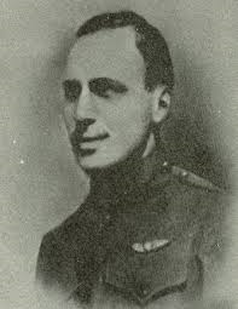John Reading Schley was born on October 12, 1894. He was the son of Steiner Schley and Lilian F. Kunkel Schley. As a boy, John Reading Schley became a member of Evangelical Reformed Church of Frederick. Early education was attained at the Frederick Academy (Frederick College), from which Schley graduated in 1912 at the head of the class. John Reading Schley went to a recruiter’s office on April 12, 1917 and enlisted in the New York Naval Reserves as a coxswain on a submarine chaser. He apparently became weary waiting to be placed on active duty. At his request, he was transferred to the Aviation Signal Corps Service at Fort Myer, VA, on August 18th, 1917. From there, Schley was then sent to the United States School of Aeronautics at the Georgia Institute of Technology. He received his diploma as “flying cadet” from the Atlanta-based institution on October 19, 1917. One week later, John Reading Schley was sent to France to be trained to fly. On May 18th, 1918, John Reading Schley was commissioned First Lieutenant. He spent that summer and the following autumn at Chateauroux and Issoudun (France). In mid-October (1918), Schley was granted leave to be spent on the French Riviera. He had been ill, and this furlough was thought to help him make a full recovery. Upon his return, he hastily resumed advanced training flights at Issoudun. In hindsight, it is thought that he may not have been well-enough to resume the rigorous training schedule. He would lose his life on a cross-country flight that commenced on October 22nd, 1918, 20 days before the war’s end. Lt. Schley was only 24 years old.
Military records report that Schley actually suffered a heart attack and lost control of his airplane on that fateful day. He was said to have drifted for a while, before hitting the ground. The young aviator was found unconscious and immediately taken to a hospital. He died and was buried in a military temporary cemetery on the grounds of the 3rd Aviation Center at Issoudun. Two years later, his body would be dis-interred and sent back home to his hometown of Frederick for reburial. Accompanying his remains, was the “military issue” marble cross that had marked his original gravesite.
Source of information:http://www.mountolivetcemeteryinc.com/stories-in-stone-blog/fredericks-lost-flyboy-of-world-war-i

PRIVATE CITIZENS SUPPORTING AMERICA'S HERITAGE
American
War Memorials Overseas, Inc.
War Memorials Overseas, Inc.
Schley John Reading
Name:
John Reading Schley
Rank:
First Lieutenant
Serial Number:
Unit:
U.S. Army Air Service
Date of Death:
1918-10-22
State:
Maryland
Cemetery:
Mount Olivet Cemetery, Frederick, Maryland
Plot:
Row:
Grave:
Decoration:
Comments:
